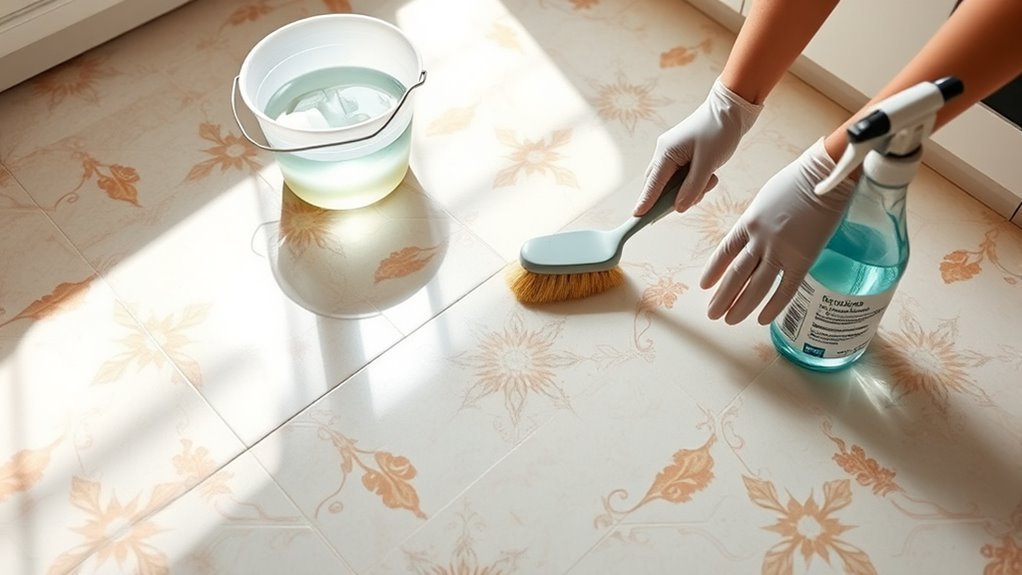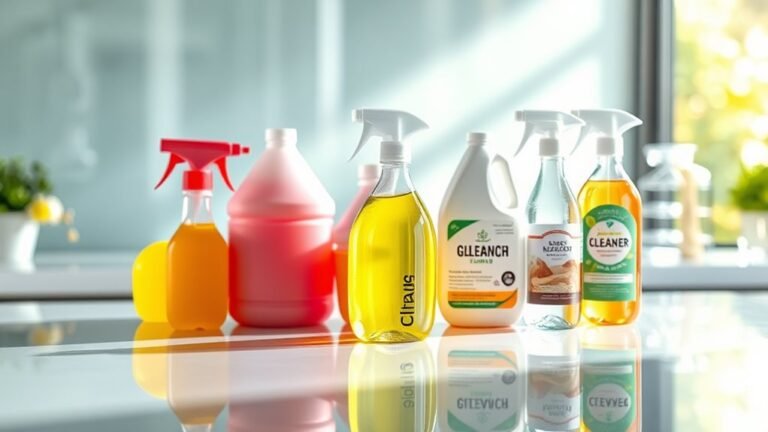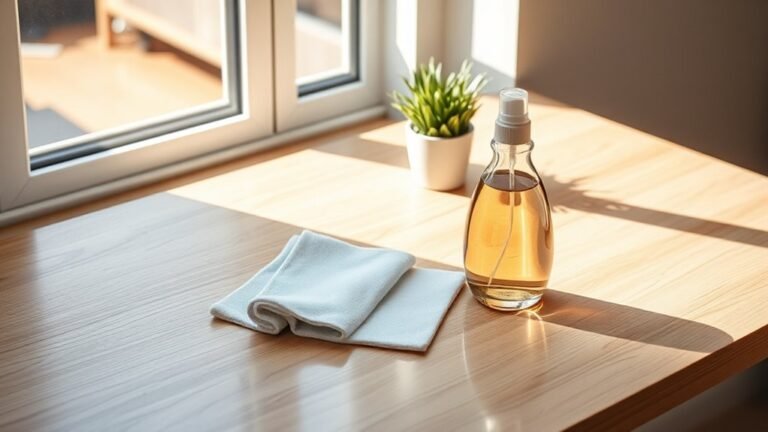The Right Way to Clean Porcelain and Ceramic Tiles
To clean porcelain and ceramic tiles right, start by sweeping or vacuuming daily to remove dust and debris. Use a pH-neutral cleaner and a microfiber cloth or soft brush for gentle, effective scrubbing. Spot clean spills quickly to avoid stains, and mop regularly with warm water and mild detergent. Don’t forget to care for grout by scrubbing it gently and sealing it when needed. Keep following these tips, and you’ll maintain your tiles’ shine and durability for years.
Understanding Porcelain and Ceramic Tile Surfaces

When you’re dealing with porcelain and ceramic tiles, it’s important to know their differences to clean them properly. Porcelain tiles usually boast a glossy finish that repels dirt and stains better, making them a bit easier to maintain. Ceramic tiles, on the other hand, often show more texture variation, which can trap dust and grime if you’re not careful. Understanding these surface traits lets you choose the right cleaning approach without risking damage. You want your tiles looking fresh without feeling restricted by complicated routines. So, recognizing whether you’re working with porcelain’s sleek gloss or ceramic’s textured charm gives you the freedom to clean effectively, preserving their beauty and your peace of mind.
Essential Tools and Cleaning Supplies
Since proper cleaning starts with the right tools, you’ll want to gather a few essentials before you begin. Having the right supplies enables you to maintain your porcelain and ceramic tiles efficiently and effortlessly.
Here are four must-have items:
- Microfiber cloths – Perfect for wiping away dust and residue without scratching your tiles.
- Cleaning brushes – Choose soft-bristled ones to tackle grout and stubborn dirt gently.
- pH-neutral tile cleaner – Guarantees effective cleaning without damaging your tile’s finish.
- Bucket and mop – For rinsing and drying, keeping everything streak-free and fresh.
With these tools, you’re free to keep your tiles looking flawless, enjoying long-lasting beauty without hassle or damage.
Daily Cleaning Techniques for Tiles

Anyone can keep porcelain and ceramic tiles looking their best with a simple daily cleaning routine. By following daily maintenance tips and adjusting tile cleaning frequency based on foot traffic, you free yourself from tough scrubbing later. Use a soft broom or vacuum to remove dirt, then mop with warm water and a mild detergent. Avoid harsh chemicals to protect your tiles.
| Time of Day | Task | Purpose |
|---|---|---|
| Morning | Sweep or vacuum | Remove dust and debris |
| Afternoon | Spot clean spills | Prevent stains |
| Evening | Mop with mild cleaner | Maintain shine and hygiene |
| Weekly | Check grout lines | Early dirt detection |
| Monthly | Deep rinse | Remove build-up |
Stick to these steps, and your tiles will stay crisp and welcoming every day.
Removing Stubborn Stains Safely
When you spot a stubborn stain on your tiles, the first step is figuring out what kind it is. Using safe cleaning solutions tailored to those stains helps protect your tile’s surface. Let’s look at effective techniques to remove tough spots without causing damage.
Identifying Stain Types
How do you know which cleaning method will work best for your tile stains? It all starts with stain identification. Different stain types require different approaches, so recognizing them is key to effective and safe cleaning.
Here are four common stain types you might encounter:
- Organic stains – like coffee, tea, or food spills.
- Oil-based stains – such as grease or makeup.
- Mineral stains – caused by hard water or rust.
- Dye stains – from inks or hair color.
Safe Cleaning Solutions
Three safe cleaning solutions can effectively tackle stubborn stains on your porcelain and ceramic tiles without causing damage. You can rely on eco friendly cleaners, gentle vinegar solutions, and baking soda mixtures to keep your floors spotless while preserving freedom from harsh chemicals. Here’s a quick guide:
| Solution | Benefits | Usage Tips |
|---|---|---|
| Eco Friendly Cleaners | Non-toxic, safe for pets & kids | Follow label instructions |
| Vinegar Solutions | Natural disinfectant, deodorizer | Dilute with water to avoid etching |
| Baking Soda Mix | Mild abrasive, stain remover | Make a paste for spot cleaning |
Stain Removal Techniques
Although porcelain and ceramic tiles are durable, stubborn stains can still challenge your cleaning routine. Don’t let these marks restrict your freedom; tackle them with smart stain removal techniques. First, understand stain prevention methods like sealing grout to minimize absorption. Next, choose stain fighting ingredients such as baking soda or hydrogen peroxide for gentle yet effective cleaning. Here’s how to proceed:
- Apply a paste of baking soda and water to the stain.
- Let it sit for 10-15 minutes.
- Scrub gently with a soft brush to avoid scratching.
- Rinse thoroughly and dry.
Caring for Grout Between Tiles
You’ll want to keep your grout clean to maintain the look and durability of your tiles. Using the right stain removal methods can make a big difference without causing damage. Let’s go over some basic cleaning tips and ways to protect your grout from wear.
Grout Cleaning Basics
Grout lines act like the skeleton of your tiled surface, holding everything together but often collecting dirt and stains over time. To keep your grout looking fresh and maintain the freedom to enjoy your space without constant worry, you’ll want to focus on these basics:
- Regularly sweep and mop to prevent dirt buildup.
- Use a gentle brush with a mild cleaner to scrub grout lines.
- Explore grout sealing options to protect against moisture and stains.
- Consider grout color choices that either hide stains or enhance your tile’s look.
Stain Removal Techniques
Keeping your grout clean is a continuous effort, but when stains do appear, knowing how to tackle them can save you time and frustration. For effective stain removal, start with a baking soda and water paste applied to the grout, scrub gently with a brush, and rinse thoroughly. Avoid harsh chemicals that could damage grout. Regular stain prevention includes sealing grout and wiping spills immediately.
| Stain Type | Removal Method | Prevention Tip |
|---|---|---|
| Mold & Mildew | Vinegar solution | Ventilate area |
| Oil-based | Dish soap & warm water | Seal grout |
| Rust | Lemon juice & baking soda | Immediate cleanup |
| General Dirt | Baking soda paste | Regular cleaning |
Stay proactive and your grout will stay fresh and free.
Preventing Grout Damage
Although grout is durable, it can crack or wear down over time without proper care. To keep your grout looking fresh and strong, you need to focus on consistent grout maintenance and smart prevention. Here’s how you can protect your grout and enjoy the freedom of worry-free tiles:
- Apply grout sealing regularly to create a protective barrier against moisture and stains.
- Clean grout lines with a gentle brush and mild cleaner to avoid damaging the surface.
- Avoid harsh chemicals that can erode grout and cause discoloration.
- Fix small cracks immediately to prevent bigger issues down the line.
Preventative Measures to Maintain Tile Appearance
To maintain the shine and durability of your porcelain and ceramic tiles, you’ll want to adopt some simple preventative measures. These tile maintenance tips focus on surface protection and daily care to keep your floors looking fresh without hassle.
| Action | Benefit | Frequency |
|---|---|---|
| Use mats/rugs | Protects from scratches | Daily |
| Clean spills promptly | Prevents stains | Immediately |
| Avoid harsh cleaners | Preserves tile finish | Always |
| Seal grout regularly | Keeps grout looking new | Every 6 months |
Frequently Asked Questions
Can I Use Vinegar to Clean Porcelain Tiles?
You might’ve heard vinegar’s great for cleaning, but when it comes to porcelain tiles, be cautious. Vinegar benefits include cutting grease and grime, but its acidity can dull or damage tile surfaces over time. If you want to keep your tiles looking fresh without risking harm, consider cleaning alternatives like mild detergent or a pH-neutral cleaner. This way, you maintain your freedom to clean safely without sacrificing your tiles’ beauty.
Are Steam Cleaners Safe for Ceramic Tiles?
You’ll find steam cleaners pretty effective for ceramic tiles since they cut through grime without harsh chemicals. But you’ve got to be careful; high heat and moisture might damage the tile surface if it’s not sealed well. To keep your tiles safe, test a small area first and avoid prolonged steam exposure. This way, you can enjoy a thorough clean without risking your tile’s finish or durability.
How Often Should I Reseal Grout on Tiles?
You don’t want to wait forever, like a thousand years, before resealing grout! For residential maintenance, it’s smart to reseal grout every 1 to 3 years to keep it strong and looking fresh. This helps boost grout longevity and prevents stains or damage that could cramp your style. If your grout’s exposed to heavy traffic or moisture, check it more often—freedom means staying ahead, not stuck with grout troubles!
What’S the Best Way to Remove Mold From Grout?
To remove mold from grout, start by scrubbing the area with a mixture of baking soda and water or a vinegar solution. Use a stiff brush to get deep into the grout lines. After cleaning, focus on mold prevention by keeping your tiles dry and well-ventilated. Regular grout maintenance, including resealing, will help you keep mold at bay and give you the freedom to enjoy a fresh, clean space without constant worry.
Can Harsh Chemicals Damage the Tile Surface?
Yes, harsh chemicals can definitely damage your tile surface. When you use strong cleaners, chemical reactions may occur that weaken the surface integrity of your tiles, causing dullness, discoloration, or even etching. If you want to keep your tiles looking great and maintain their freedom from damage, it’s best to avoid aggressive chemicals and opt for gentler, pH-neutral cleaners that protect your tile’s finish while effectively cleaning.






